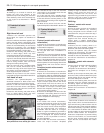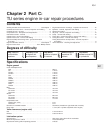
Examine the seal for signs of damage and
deterioration, and if necessary, renew it.
6 Remove the spacer from each stud, and lift
off the oil baffle plate (see illustrations).
Refitting
7 Carefully clean the cylinder head and cover
mating surfaces, and remove all traces of oil.
8 Fit the rubber seal over the edge of the
cylinder head cover, ensuring that it is
correctly located along its entire length (see
illustration).
9 Refit the oil baffle plate to the engine, and
locate the spacers in their recesses in the
baffle plate.
10 Carefully refit the cylinder head cover to
the engine, taking great care not to displace
the rubber seal.
11 Check that the seal is correctly located,
then refit the washers and cover retaining
nuts, and tighten them to the specified torque.
12 Where necessary, refit the HT lead clips to
the rear of the head cover, and securely
tighten their retaining bolts.
13 Reconnect the breather hose to the
cylinder head cover, securely tightening its
retaining clip, and reconnect the battery
negative lead.
5 Valve clearances - checking
and adjustment
2
Note: The valve clearances must be checked
and adjusted only when the engine is cold.
1 The importance of having the valve
clearances correctly adjusted cannot be
overstressed, as they vitally affect the
performance of the engine. If the clearances are
too big, the engine will be noisy (characteristic
rattling or tapping noises) and engine efficiency
will be reduced, as the valves open too late and
close too early. A more serious problem arises if
the clearances are too small, however. If this is
the case, the valves may not close fully when
the engine is hot, resulting in serious damage to
the engine (eg. burnt valve seats and/or cylinder
head warping/cracking). The clearances are
checked and adjusted as follows.
2 Remove the cylinder head cover as
described in Section 4.
3 The engine can now be turned using a
suitable socket and extension bar fitted to the
crankshaft sprocket/pulley bolt.
4 It is important that the clearance of each
valve is checked and adjusted only when the
valve is fully closed, with the rocker arm
resting on the heel of the cam (directly
opposite the peak). This can be ensured by
carrying out the adjustments in the following
sequence, noting that No 1 cylinder is at the
transmission end of the engine. The correct
valve clearances are given in the
Specifications at the start of this Chapter. The
valve locations can be determined from the
position of the manifolds.
Valve fully open Adjust valves
No 1 exhaust No 3 inlet, No 4 exhaust
No 3 exhaust No 4 inlet, No 2 exhaust
No 4 exhaust No 2 inlet, No 1 exhaust
No 2 exhaust No 1 inlet, No 3 exhaust
5 With the relevant valve fully open, check the
clearances of the two valves specified. The
clearances are checked by inserting a feeler
blade of the correct thickness between the
valve stem and the rocker arm adjusting screw
(see illustration). The feeler blade should be a
light, sliding fit. If adjustment is necessary,
slacken the adjusting screw locknut, and turn
the screw as necessary. Once the correct
clearance is obtained, hold the adjusting screw
and securely tighten the locknut. Recheck the
valve clearance, and adjust again if necessary.
6 Rotate the crankshaft until the next valve in
the sequence is fully open, and check the
clearances of the next two specified valves.
7 Repeat the procedure until all eight valve
clearances have been checked (and if
necessary, adjusted), then refit the cylinder
head cover as described in Section 4.
6 Timing belt covers - removal
and refitting
1
Removal
Upper cover
1 Slacken and remove the two retaining bolts
(one at the front and one at the rear), and
remove the upper timing cover from the
cylinder head (see illustrations).
2C•4 TU series engine in-car repair procedures
4.6a Lift off the spacers (second one
arrowed) . . .
4.6b . . . and remove the oil baffle plate 4.8 Ensure the rubber seal is correctly
located on the cover when refitting
6.1a Undo the two retaining bolts
(arrowed) . . .
5.5 Valve clearance adjustment 6.1b . . . and remove the timing belt upper
cover
Turning the engine will be
easier if the spark plugs are
removed first - see Chapter 1.


















